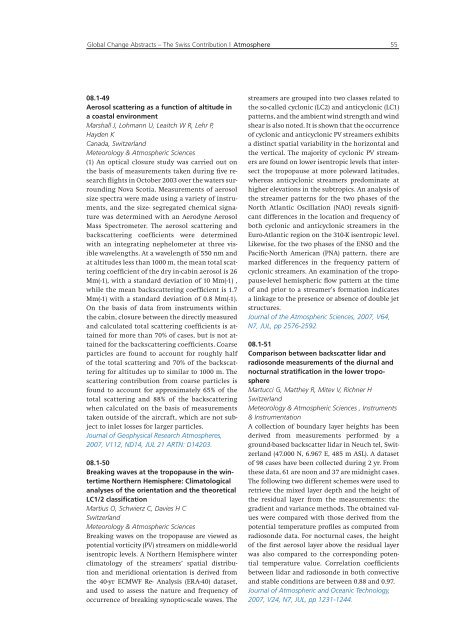Global Change Abstracts The Swiss Contribution - SCNAT
Global Change Abstracts The Swiss Contribution - SCNAT
Global Change Abstracts The Swiss Contribution - SCNAT
Create successful ePaper yourself
Turn your PDF publications into a flip-book with our unique Google optimized e-Paper software.
<strong>Global</strong> <strong>Change</strong> <strong>Abstracts</strong> – <strong>The</strong> <strong>Swiss</strong> <strong>Contribution</strong> | Atmosphere 55<br />
08.1-49<br />
Aerosol scattering as a function of altitude in<br />
a coastal environment<br />
Marshall J, Lohmann U, Leaitch W R, Lehr P,<br />
Hayden K<br />
Canada, Switzerland<br />
Meteorology & Atmospheric Sciences<br />
(1) An optical closure study was carried out on<br />
the basis of measurements taken during five research<br />
flights in October 2003 over the waters surrounding<br />
Nova Scotia. Measurements of aerosol<br />
size spectra were made using a variety of instruments,<br />
and the size- segregated chemical signature<br />
was determined with an Aerodyne Aerosol<br />
Mass Spectrometer. <strong>The</strong> aerosol scattering and<br />
backscattering coefficients were determined<br />
with an integrating nephelometer at three visible<br />
wavelengths. At a wavelength of 550 nm and<br />
at altitudes less than 1000 m, the mean total scattering<br />
coefficient of the dry in-cabin aerosol is 26<br />
Mm(-1), with a standard deviation of 10 Mm(-1) ,<br />
while the mean backscattering coefficient is 1.7<br />
Mm(-1) with a standard deviation of 0.8 Mm(-1).<br />
On the basis of data from instruments within<br />
the cabin, closure between the directly measured<br />
and calculated total scattering coefficients is attained<br />
for more than 70% of cases, but is not attained<br />
for the backscattering coefficients. Coarse<br />
particles are found to account for roughly half<br />
of the total scattering and 70% of the backscattering<br />
for altitudes up to similar to 1000 m. <strong>The</strong><br />
scattering contribution from coarse particles is<br />
found to account for approximately 65% of the<br />
total scattering and 88% of the backscattering<br />
when calculated on the basis of measurements<br />
taken outside of the aircraft, which are not subject<br />
to inlet losses for larger particles.<br />
Journal of Geophysical Research Atmospheres,<br />
2007, V112, ND14, JUL 21 ARTN: D14203.<br />
08.1-50<br />
Breaking waves at the tropopause in the wintertime<br />
Northern Hemisphere: Climatological<br />
analyses of the orientation and the theoretical<br />
LC1/2 classification<br />
Martius O, Schwierz C, Davies H C<br />
Switzerland<br />
Meteorology & Atmospheric Sciences<br />
Breaking waves on the tropopause are viewed as<br />
potential vorticity (PV) streamers on middle-world<br />
isentropic levels. A Northern Hemisphere winter<br />
climatology of the streamers’ spatial distribution<br />
and meridional orientation is derived from<br />
the 40-yr ECMWF Re- Analysis (ERA-40) dataset,<br />
and used to assess the nature and frequency of<br />
occurrence of breaking synoptic-scale waves. <strong>The</strong><br />
streamers are grouped into two classes related to<br />
the so-called cyclonic (LC2) and anticyclonic (LC1)<br />
patterns, and the ambient wind strength and wind<br />
shear is also noted. It is shown that the occurrence<br />
of cyclonic and anticyclonic PV streamers exhibits<br />
a distinct spatial variability in the horizontal and<br />
the vertical. <strong>The</strong> majority of cyclonic PV streamers<br />
are found on lower isentropic levels that intersect<br />
the tropopause at more poleward latitudes,<br />
whereas anticyclonic streamers predominate at<br />
higher elevations in the subtropics. An analysis of<br />
the streamer patterns for the two phases of the<br />
North Atlantic Oscillation (NAO) reveals significant<br />
differences in the location and frequency of<br />
both cyclonic and anticyclonic streamers in the<br />
Euro-Atlantic region on the 310-K isentropic level.<br />
Likewise, for the two phases of the ENSO and the<br />
Pacific-North American (PNA) pattern, there are<br />
marked differences in the frequency pattern of<br />
cyclonic streamers. An examination of the tropopause-level<br />
hemispheric flow pattern at the time<br />
of and prior to a streamer’s formation indicates<br />
a linkage to the presence or absence of double jet<br />
structures.<br />
Journal of the Atmospheric Sciences, 2007, V64,<br />
N7, JUL, pp 2576-2592.<br />
08.1-51<br />
Comparison between backscatter lidar and<br />
radiosonde measurements of the diurnal and<br />
nocturnal stratification in the lower troposphere<br />
Martucci G, Matthey R, Mitev V, Richner H<br />
Switzerland<br />
Meteorology & Atmospheric Sciences , Instruments<br />
& Instrumentation<br />
A collection of boundary layer heights has been<br />
derived from measurements performed by a<br />
ground-based backscatter lidar in Neuch tel, Switzerland<br />
(47.000 N, 6.967 E, 485 m ASL). A dataset<br />
of 98 cases have been collected during 2 yr. From<br />
these data, 61 are noon and 37 are midnight cases.<br />
<strong>The</strong> following two different schemes were used to<br />
retrieve the mixed layer depth and the height of<br />
the residual layer from the measurements: the<br />
gradient and variance methods. <strong>The</strong> obtained values<br />
were compared with those derived from the<br />
potential temperature profiles as computed from<br />
radiosonde data. For nocturnal cases, the height<br />
of the first aerosol layer above the residual layer<br />
was also compared to the corresponding potential<br />
temperature value. Correlation coefficients<br />
between lidar and radiosonde in both convective<br />
and stable conditions are between 0.88 and 0.97.<br />
Journal of Atmospheric and Oceanic Technology,<br />
2007, V24, N7, JUL, pp 1231-1244.

















